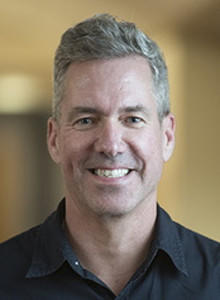
John W. Osborn, Jr, Ph.D.
E-MAIL: [email protected]
Advising Statement: Here
Research Interests:
Research in my laboratory is directed towards gaining an integrative understanding of the role of the central nervous system in the long-term regulation of arterial pressure and the pathogenesis of hypertension. At the present time we are investigating how circulating hormones, such as angiotensin II and aldosterone, are monitored by specialized sites within the brain called circumventricular organs. We are investigating how these regions influence ongoing sympathetic nerve discharge and ultimately the regulation of arterial pressure. Our long-term goal is to understand, in a quantitative way, the role of such hormonal-sympathetic interactions in normal physiology and the pathophysiology of hypertension. Specifically, we are studying how such interactions are influenced by alterations in dietary salt in hopes of understanding the neurogenic basis of salt-dependent hypertension. A variety of experimental approaches are employed to address these issues including state-of-the-art long-term monitoring of cardiovascular hemodynamics and direct measurement of sympathetic nerve discharge in awake animals. We have also initiated a collaborative project with the Department of Mathematics to begin developing new mathematical models of how the nervous system regulates cardiovascular function over long periods of time.
In addition to the work in my own laboratory, I am the coordinator for a newly formed national research effort to study the role of the brain in cardiovascular diseases. "The Neurogenic Cardiovascular Diseases Consortium" is a novel NIH funded project which joins 5 major research Universities to investigate neurogenic cardiovascular diseases at all levels of regulation; gene, single cell, neural networks and whole animal. This work will be carried out by Universities of Minnesota (home institution), Pittsburgh, Texas-San Antonio, Florida-Gainesville and Michigan State University.
Selected Publications:
(For a comprehensive list of recent publications, refer to PubMed, a service provided by the National Library of Medicine.)
- Periglomerular afferent innervation of the mouse renal cortex. Front Neurosci. 2023 Jan 26;17:974197.
- Weber MA, Osborn JW. Improved understanding of renal nerve anatomy: An opportunity to enhance denervation treatment of hypertension. JACC Cardiovasc Interv. 2021 Feb 8;14(3):316-318.
- Osborn JW, Tyshynsky R, Vulchanova L. Function of renal nerves in kidney physiology and pathophysiology. Annu Rev Physiol. 2021;83:429-450.
- Razzoli M, Lindsay A, Law ML, Chamberlain CM, Southern WM, Berg M, Osborn J, Engeland WC, Metzger JM, Ervasti JM, Bartolomucci A. Social stress is lethal in the mdx model of Duchenne muscular dystrophy. EBioMedicine. 2020 Mar 3:102700.
- Banek CT, Gauthier MM, Baumann DC, Van Helden D, Asirvatham-Jeyaraj N, Panoskaltsis-Mortari A, Fink GD, Osborn JW. Targeted afferent renal denervation reduces arterial pressure but not renal inflammation in established DOCA-salt hypertension in the rat. Am J Physiol Regul Integr Comp Physiol. 2018;314(6):R883-R891.
- Osborn JW, Banek CT. Catheter-based renal nerve ablation as a novel hypertension therapy: Lost, and then found, in translation. Hypertension. 2018 Mar;71(3):383-388.
- Hart EC, Head GA, Carter JR, Wallin BG, May CN, Hamza SM, Hall JE, Charkoudian N, Osborn JW. Recording sympathetic nerve activity in conscious humans and other mammals: guidelines and the road to standardization. Am J Physiol Heart Circ Physiol. 2017;312:H1031-H1051
- Osborn JW, Foss JD. Renal nerves and long-term control of arterial pressure. Compr Physiol. 2017;7:263-320.
- Banek CT, Knuepfer MM, Foss JD, Fiege JK, Asirvatham-Jeyaraj N, Van Helden D, Shimizu Y, Osborn JW. Resting afferent renal nerve discharge andrenalinflammation: Elucidating the role of afferent and efferent renal nerves in deoxycorticosterone acetate salt hypertension. Hypertension. 2016;68:1415-1423.
- Foss JD, Fink GD, Osborn JW. Differential role of afferent and efferent renal nerves in the maintenance of early and late phase Dahl S hypertension. Am J Physiol Regul Integr Comp Physiol. 2016;310:R262-7.
- Annoni EM, Xie X, Lee SW, Libbus I, KenKnight BH, Osborn JW, Tolkacheva EG. Intermittent electrical stimulation of the right cervical vagus nerve in salt-sensitive hypertensive rats: effects on blood pressure, arrhythmias, and ventricular electrophysiology. Physiol Rep. 2015;3(8). pii: e12476.
- Han R, Wang X, Bachovchin W, Zukowska Z, Osborn JW. Inhibition of dipeptidyl peptidase 8/9 impairs preadipocyte differentiation. Sci Rep. 2015 Aug 5;5:12348.
- Xiao L, Kirabo A, Wu J, Saleh MA, Zhu L, Wang F, Takahashi T, Loperena R, Foss JD, Mernaugh RL, Chen W, Roberts J 2nd, Osborn JW, Itani HA, Harrison DG. Renal denervation prevents immune cell activation and renal inflammation in sngiotensin II-induced hypertension. Circ Res. 2015;117(6):547-57.
- Foss JD, Wainford RD, Engeland WC, Fink GD, Osborn JW. A novel method of selective ablation of afferent renal nerves by periaxonal application of capsaicin. Am J Physiol Regul Integr Comp Physiol. 2015;308(2):R112-22.
- Averina VA, Othmer HG, Fink GD, Osborn JW. A mathematical model of salt-sensitive hypertension: the neurogenic hypothesis. J Physiol. 2015;593(14):3065-75.
- Kuroki MT, Fink GD, Osborn JW. Comparison of arterial pressure and plasma ANG II responses to three methods of subcutaneous ANG II administration. Am J Physiol Heart Circ Physiol. 2014 Sep 1;307(5):H670-679.
Current Graduate Students:
Roman Tyshynsky (Neuroscience, University of Minnesota).
Former Graduate Students:
Marcos Kuroki (Ph.D. 2013, Neuroscience, University of Minnesota).
Britta Veitenheimer (Ph.D. 2012, Neuroscience, University of Minnesota).
Joanna Abrams (Ph.D. 2008, Neuroscience, University of Minnesota).
John P. Collister, D.V.M, Ph.D. 1999. Graduate program in Molecular Veterinary Biosciences. Dissertation: "Angiotensin-sympathetic interactions in the long-term control of arterial pressure". Current Position: Research Associate, Department of Veterinary PathoBiology, University of Minnesota.
David P. Slovut, M.D., Ph.D. 1998. Graduate Program in Cellular and Integrative Physiology. Dissertation: "Mechanisms of heart rate variablity after cardiac allograft transplantation. Current Position: Cardiology Fellow, University of Michigan.
Scott Carlson, Ph.D. 1996. Graduate Program in Cellular and Integrative Physiology. Dissertation: "The role of peripheral osmoreceptors in the control of arginine vasopressin release". Current Position: Assistant Professor, Luther College.
